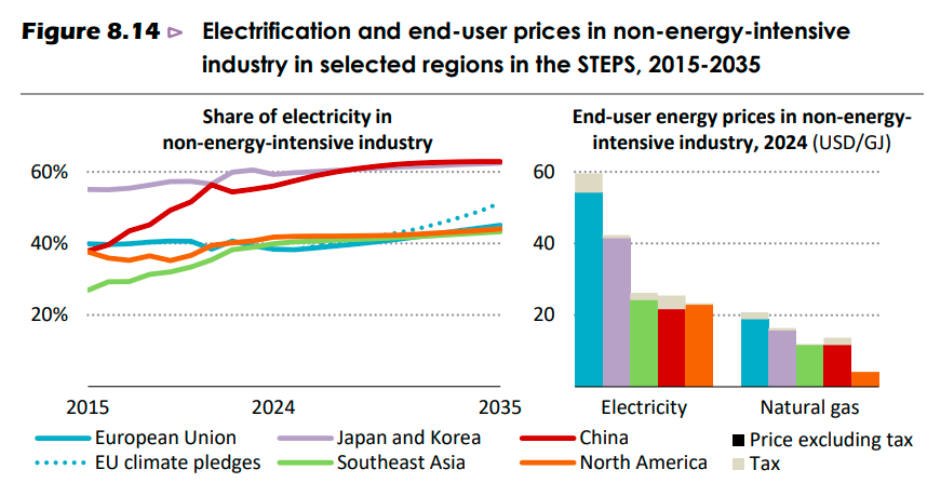The International Energy Agency’s World Energy Outlook 2025 outlines Europe’s ambitious path toward energy transition, climate neutrality, and energy security. The European Union (EU) is advancing a rapid transformation to meet its 2030 and 2050 targets, emphasizing renewable expansion, electrification, and industrial decarbonisation. Below is a summary of ten key findings on Europe’s energy outlook through 2035 according to the IEA report.
1. EU Targets 55 Percent Emission Reduction by 2030
The European Union aims for a 55 percent reduction in greenhouse gas emissions by 2030, supported by 600 GW of new solar PV deployment and an 11.7 percent decline in total final energy consumption. These measures are designed to boost energy security, cut fossil fuel dependence, and enhance competitiveness.
2. Reduced Dependence on Imported Fossil Fuels
The energy crisis following Russia’s invasion of Ukraine underscored the EU’s reliance on imported natural gas. Although prices have eased since the 2022 peak, they remain more than 20 percent above pre-crisis levels, reinforcing the need for self-sufficiency through renewables and efficiency improvements.
3. Renewables Lead the Energy Mix by 2035
By 2035, the share of renewables in EU power generation will exceed 70 percent, with coal demand dropping to nearly one-ninth of current levels and natural gas consumption declining by over 40 bcm. Oil demand will also fall sharply, driven by the widespread adoption of electric vehicles (EVs).
4. Electrification and Grid Expansion Drive the Transition
Electricity generation in the EU will grow by 40 percent by 2035, with its share in final energy consumption rising by nine percentage points. Grid investment is set to nearly double, improving flexibility and enabling greater renewable integration across the continent.
5. Nuclear Power Gains Renewed Support
Several EU nations are reaffirming commitments to nuclear power. Belgium will keep existing reactors online, France plans to finance six new nuclear reactors, and Italy is reconsidering reintroducing nuclear power as part of its long-term energy strategy.
6. Deep Decarbonisation of Industry Through Innovation
Decarbonising hard-to-abate industries remains a priority. The EU’s Clean Industrial Deal allocates EUR 100 billion to industrial decarbonisation initiatives, including EUR 1 billion for a fixed premium auction to decarbonise process heat, alongside Germany’s EUR 4 billion carbon contract support.
7. Industrial Heat Pumps to Cut Fossil Fuel Use
Industrial heat pumps (IHPs) are central to the electrification of industrial processes. Consuming up to five times less energy than conventional boilers, IHPs can significantly cut fossil fuel imports and emissions while enhancing competitiveness across sectors.
8. Overcoming Barriers to Electrification
Despite strong potential, IHP adoption has been slow due to high upfront costs and infrastructure complexity. Successful examples from New Zealand and Germany show that targeted subsidies, expertise programs, and carbon contracts can accelerate deployment in Europe.
9. Flexible Electrification and Smart Grids Boost Efficiency
Electric boilers and flexible electrification strategies can help stabilise the grid and reduce costs. Industrial consumers with demand-side flexibility and power purchase agreements can benefit from low or even negative wholesale electricity prices, increasingly common in markets like Finland.
10. Strengthened Energy Security and Cross-Border Integration
To meet the 2030 target of at least 42.5 percent renewables in the energy mix, the EU plans to add 64 GW of cross-border transmission capacity between 2025 and 2030. These efforts enhance electricity security, accelerate decarbonisation, and support regional energy integration.
Conclusion
Europe’s energy future hinges on accelerating renewable deployment, expanding electrification, and securing affordable, low-carbon energy for all sectors. The World Energy Outlook 2025 underscores that with strong policy support, innovation, and cross-border cooperation, the EU is on track to become a global model for clean and resilient energy systems.
Baburajan Kizhakedath

